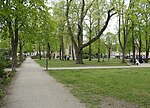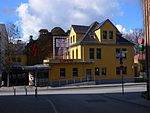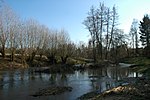Burgberg (Erlangen)
Erlangen

The Burgberg, also sometimes referred to as Strawberry Hill, is a 332-meter-high sandstone hill in Erlangen, Germany. It was quarried in the 15th century and its southern slope has been used to house beer cellars since 1675. The cellar storage made Erlangen a pioneer concerning beer exports. The "Erlangen Bergkirchweih" has taken place in and around the cellars every Whitsun since 1775.
Excerpt from the Wikipedia article Burgberg (Erlangen) (License: CC BY-SA 3.0, Authors, Images).Burgberg (Erlangen)
Burgbergstraße, Erlangen Burgberg
Geographical coordinates (GPS) Address Nearby Places Show on map
Geographical coordinates (GPS)
| Latitude | Longitude |
|---|---|
| N 49.608833333333 ° | E 11.012583333333 ° |
Address
Burgbergstraße 44
91054 Erlangen, Burgberg
Bavaria, Germany
Open on Google Maps








